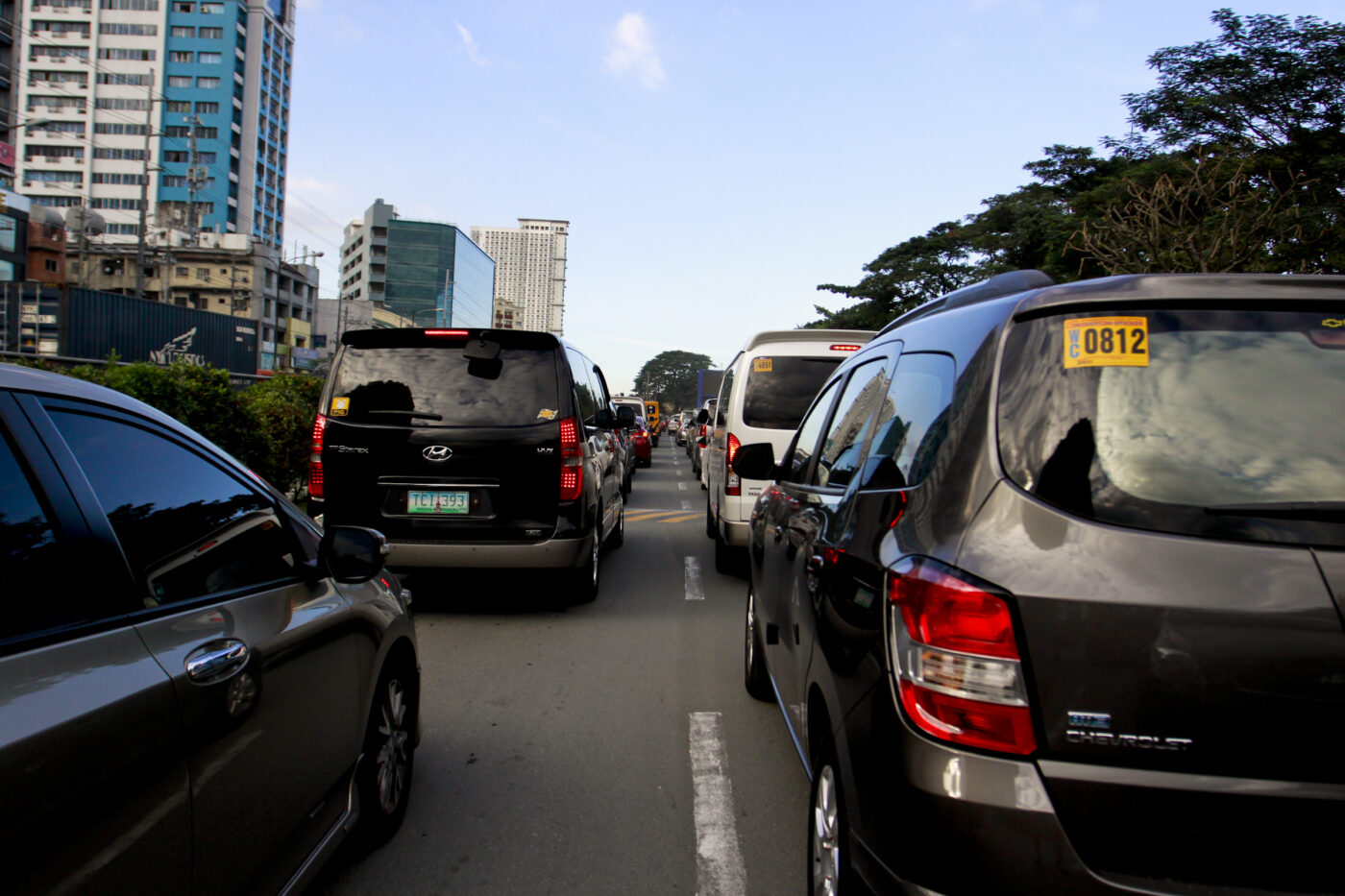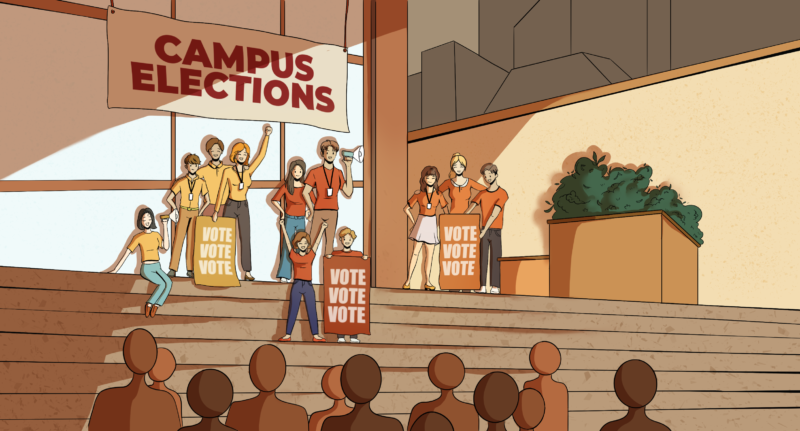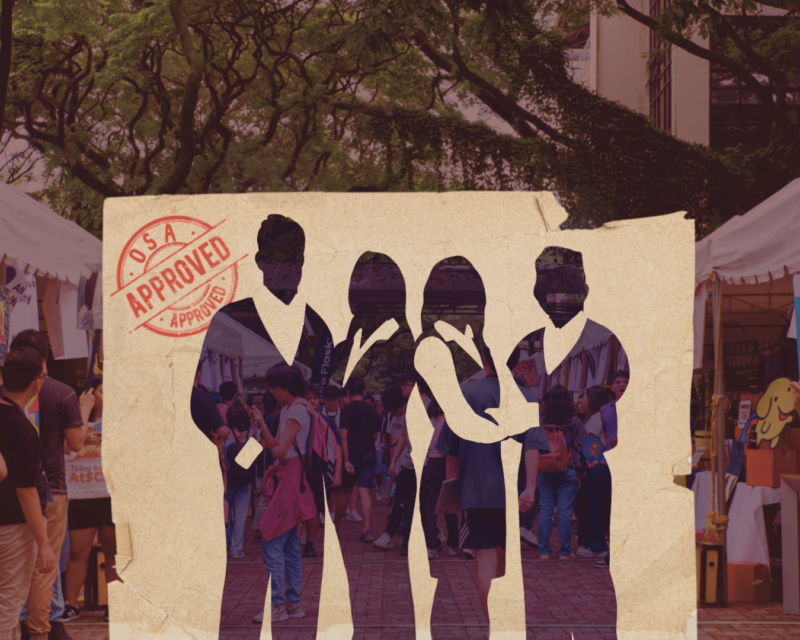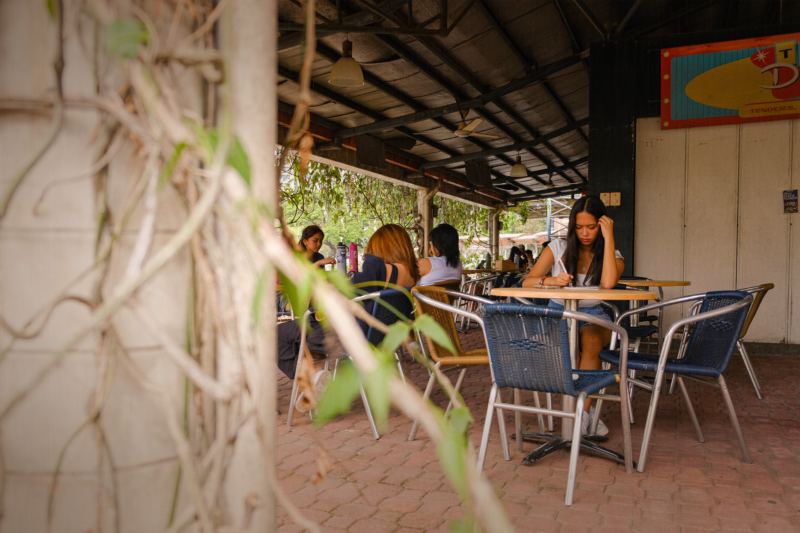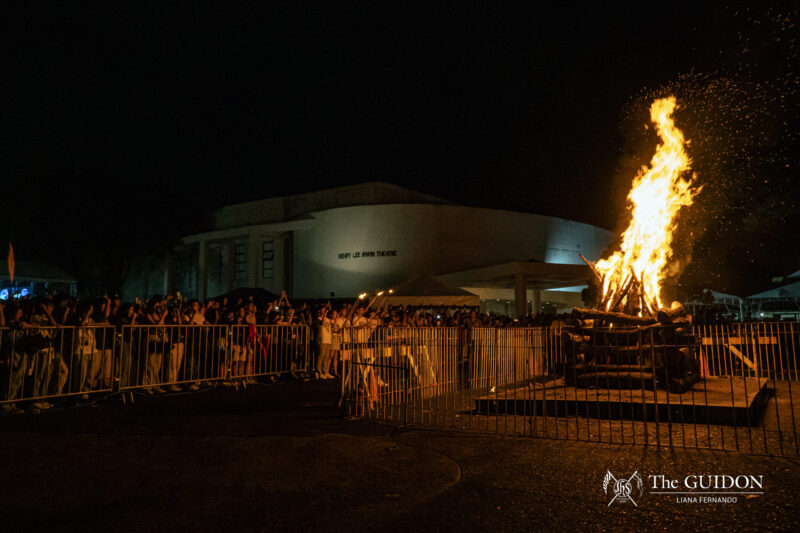Last September 10, the Campus Safety and Mobility Office (CSMO) issued a memorandum: In three days, the U-turn slots along Katipunan Avenue would be closed and replaced by the reopening of the intersections fronting the Ateneo campus and Miriam College (MC). The Metropolitan Manila Development Authority’s (MMDA) decision was radical, if not baffling.
However, there was no stopping the change that the MMDA wanted to implement. On September 13, traffic was once again in the hands of three colors and timers. Everything worked that Saturday without any huge consequences. The following Monday, though, was the complete opposite. For hundreds of Ateneans riding or driving private cars to school that morning, it was a nightmare.
The weeks after brought on a flood of changes in on-campus traffic routing. The MMDA, meanwhile, opened a zipper lane and switched off the traffic lights during the morning peak hours.
Two months later, a sense of normalcy is beginning to settle—a result of both the traffic situation improving, and of just getting used to the longer trips to and from school. However, the experience has left a bitter taste in the mouths of many—and a lot of questions.
Pressure points
Even before recent events, traffic has already been a primary concern of the administration. Last year, for example, the university implemented a one-way system around campus, an effort spearheaded by the Ateneo Traffic Group (ATG), which produced extensive models of the traffic inside the Ateneo—models that still continue to be used today.
Currently, traffic management on campus falls mainly under the jurisdiction of two offices: The CSMO oversees the actual traffic systems used on campus, while the Facilities Management Office (FMO) attends to the construction and maintenance of roads and other related structures in order to carry out desired policies. Marcelino Mendoza, the director of the CSMO, explains that the CSMO is to the MMDA, while the FMO is to the the Department of Public Works and Highways (DPWH).
Both offices are keen to emphasize the fact that decisions are collective agreements among the two offices, the Office of the Vice President for Planning and, if necessary, the president of the university. This demonstrates that none of these offices have any explicit overruling power when it comes to affairs of traffic. “It’s not just, ‘I want that, I want this,’ no,” says FMO Director Michael Canlas.
As such, all of these offices had to consult each other when they made decisions in response to the MMDA’s move, something that Canlas admits “eats up a lot of time for discussion.” That being said, however, he is confident in the benefits of the collaborative approach.
Although recent changes have clearly been caused by the new traffic lights, both offices insist that other factors also matter in making decisions. For instance, some of the initial adjustments, such as the conversion of the Gate 3 entrance into a two-way point, were concessions to the MMDA’s original demands.
The university’s own push towards sustainability also weighs heavily. Thus, while the university aims to be able to accommodate the horde of cars that go in and out of campus, decisions also have to discourage the use of cars and instead promote alternative means of transportation such as bicycles and e-jeepneys. Apart from this, offices have to take into account the campus master plan, according to Canlas.
References to many other proposals in the interview testify to the capricious outside forces to which the Ateneo has to adjust. Some proposals sound outlandish, like planning to develop the Katipunan area into a campus tourist spot like Harvard University. Others seem more mundane, like finally making the northbound lane of Katipunan Ave. consistently five lanes wide
The latter was, in fact, one of the reasons behind one of the most recent changes—the closure of the Diversion Road parking area. The announcement was met with hostility, mainly from student drivers concerned with the further reduction in the tight supply of parking slots on campus.
Canlas counters, however, by claiming that there is a greater propensity for accidents along the thoroughfare. This is because Diversion Road is now used by cars coming from the John Gokongwei School of Management Student Enterprise Center or the Ateneo Grade School to circle around towards the Ateneo High School or the drop-off points at the Ricardo and Dr. Rosita Leong Hall and Gonzaga Hall. However, he denies that an actual incident has already occurred, stressing that the move was a preemptive one. He further argues that the closure was simply an “inconvenience,” as “only 86” slots were removed.
Push and pull
The information about the MMDA’s implementation of the traffic lights, Canlas says, came on a Monday in August.
Prior to the call that summoned them to a meeting at the MMDA’s headquarters in Guadalupe, neither the FMO nor the CSMO, or indeed any office in the university, had been informed about the new scheme. Canlas says that they attended the meeting without knowing the context in which it was held. It was then that they were informed about the traffic lights, and that the MMDA was planning to roll out the scheme on the Friday of the same week. In fact, people had already come to install the traffic lights that Monday.
The word “no” pops up several times when Canlas and Mendoza are asked if they were consulted about the scheme. It was not, they say, something that they could question. The only thing they could do at the time was to postpone the implementation of the traffic lights to September 13, a Saturday, so that they could test it without the added challenge of the weekday rush. Aside from that, they requested for certain adjustments, such as the provision of timers, which had not initially been part of the MMDA’s plan.
Canlas and Mendoza allege that when the MMDA came to them, they had not done any studies on the amount of south- bound and northbound vehicles or shown the Ateneo an origin- destination matrix.
This lack of vehicle counts and origin-destination matrices led to the MMDA’s setting the timer for the traffic lights at Gate 3 to 35 seconds at first. This meant that hundreds of vehicles inside the Ateneo were locked up, and, consequently, the flow of traffic outside was locked up as well. This is why, Mendoza says, during peak hours—5:30 to 8:00 AM—the management of the traffic lights switches to manual. This means the MMDA officials run the timers themselves—and the number of seconds allotted for vehicles driving through in- tersections increases.
Mendoza, however, points out that on the National Capital Region level, credit must be given to the MMDA for im- proving traffic conditions par- ticularly along C-5. However, it must be noted that there are no schools found by that road. As an example, he compares the implementation of the traffic lights outside Eastwood City to the one outside the Ateneo and MC. In the case of the former, the problems regarding con- gestion were solved in roughly two days. On the other hand, it took the MMDA two to three weeks to address the problems along Katipunan Ave., and minor adjustments—such as manual timers and opening up alterna- tive routes inside the Ateneo campus—are still being made.
He adds that the MMDA and the Ateneo coordinate with each other everyday in order to ease the traffic. At present, it is still difficult to let the timer run automatically during peak hours, as both parties have yet to arrive at the optimum number of seconds to be allotted for the traffic lights to change. Mendoza also says that the Ateneo has a pointperson in the MMDA whom they can call, should there be an event held on campus that will lead to a high influx of vehicles outside of peak hours.
Panal also lauds the excellent working relationship between the Ateneo and the MMDA. However, he refutes that the MMDA installed the traffic lights on a whim without any good reason to do so. He insists that the MMDA, too, takes great interest in the state of traffic in the Ateneo. Proof of this is the numerous recommendations he has made to improve the overall situation in Katipunan Ave.— such as the installation of pedestrian lights. As the overall head of enforcement of traffic in the Katipunan area, Panal emphasizes that he and his enforcers take their work seriously, no matter how difficult it may be.
A sustainable future
Amidst of all these problems, Canlas and Mendoza remain optimistic for the future of traffic in the Ateneo. While they say that they cannot predict conditions in the following years, such as an increase in the number of vehicles, they have several programs on the drawing board that are in keeping with the Ateneo’s thrust for sustainability.
Opening up the bike lanes on campus is only one of the Ateneo’s many long-term plans. They are looking into tie-ups with private companies to provide more shuttle and bus services for the grade school and high school students, as well as an increase in e-jeeps on campus and improvements in the carpool system for students of the Loyola Schools. Canlas shares an innovation of the MMDA in the 1980s, the Love Bus, which traveled from Alabang to Katipunan Ave. He says that if the MMDA could bring this back, then the students coming from faraway areas could simply ride this bus and get off at the Ateneo’s pedestrian gates, where they could then board the e-jeeps plying the campus roads.
Ultimately, Canlas and Mendoza want to assure the community that the FMO and the CSMO are always looking at the bigger picture, and the decisions they are making will be for the benefit of everyone in the future. Already, Canlas says, he can hear people saying that the traffic conditions are getting better.
Meanwhile, along Katipunan Ave., the timer ticks down to zero. Above the sea of cars, the traffic lights turn red.
Editor’s Note: MMDA Chairman Francis Tolentino was not available for interview.
[seperator style=”style1″]Routes of change [/seperator]By Nathan V. Javier and Mivan V. Ong
Due to the worsening traffic situation, the Campus Safety and Mobility Office, and the Metro Manila Development Authority have been trying to alter the traffic scheme inside and outside the university in order to reduce traffic. These changes include the reinstallation of traffic lights along Katipunan Ave. and the opening of Gate 3 Annex, among others.
[columns][two-columns]July 7, 2014
- The entrance and exit of the North Car Park are switched. The entrance is now in Parade Loop, directly across Bellarmine Field.
September 10, 2014
- The midway U-turn slots along Katipunan Ave. are closed. Traffic lights are used instead, creating intersections on the avenue.
- The new scheme makes vehicles coming from University of the Philippines (UP) Balara enter the Ateneo through a left turn to Gate 3.
- Gate 3 becomes an exit point for southbound vehicles via left turn at the intersection.
- Part of University Rd.—from Gate 3 to the corner of Fr. Arrupe Rd.—is two-way.
- Ateneo Grade School (AGS)-bound vehicles are encouraged to enter via Gates 1 and 2.
- Northbound vehicles exiting from AGS are advised to exit at Gate 2.5, while Southbound exiting vehicles are advised to take the CP Garcia U-turn slot.
September 13, 2014
- For southbound vehicles coming from UP Balara, the first and second lanes from center island of Katipunan Ave. are designated for Ateneo-bound vehicles turning left to Gate 3, while the third lane is for trucks.
- Gate 3 is used for entrance only.
- Traffic lights along Katipunan Ave. restored “to address worsening traffic situation.”
September 17, 2014
- Gate 3 is now two-way. Exit and entrance have two lanes each.
- Exit time via Gate 3 is extended to 45 seconds.
- Vehicles coming from Fr. Arrupe Rd. can pass through Gate 3 Auxiliary Road in order to exit using Gate 3, and vehicles exiting to Katipunan Ave. can exit at Gate 3.5 via Northwest Carpark Side Road.
[/two-columns]
[two-columns]- Matheson Drive in front of the Church of Gesù accommodates two-way traffic.
- First pedestrian lane in front of Ricardo and Dr. Rosita Leong Hall is closed.
- On the southbound lane of Katipunan Ave., a counter-flow lane will be implemented from the footbridge by Gate 2.5 to the intersection by Gate 3 from 6:00 AM to 8:00 AM to accommodate vehicles heading to the UP Balara
September 24, 2014
- Gate 3 Annex now serves as the exit gate for vehicles passing through Diversion Rd. Right lane vehicles are to go straight to CP Garcia, while left lane vehicles may take a left turn at the intersection traffic light. Vehicles wishing to go back to University Rd. can take Diversion Rd. and turn right.
- Gate 2.5 is closed, while Gate 3 is only open as an entrance.
- The pedestrian crossing in front of Ricardo and Dr. Rosita Leong Hall is re-opened.
October 2, 2014
- Gate 2.5 is re-opened to help decongest traffic inside the university.
October 18, 2014
- The John Gokongwei School of Management (JGSOM) faculty and staff car park will be temporarily closed from December 1, 2014 to July 31, 2015 due to the construction projects around the JGSOM building and PLDT-Convergent Technologies Center areas.
November 3, 2014
- Diversion Rd. car park is closed.
November 12, 2014
- Bike lanes are placed along major university roads such as Fr. Masterson Dr., University Rd. and Parade Loop.

